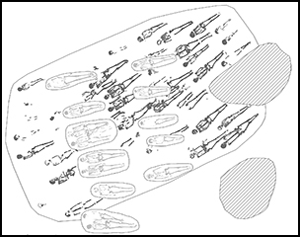Crossref Citations
This article has been cited by the following publications. This list is generated based on data provided by
Crossref.
Hemer, Katie A.
Booth, Thomas J.
Raffone, Caterina
Mann, Colleen
Corkhill, Claire L.
and
Willmott, Hugh
2021.
‘Among his fellows cast’: A histotaphonomic investigation into the impact of the Black Death in England.
Journal of Archaeological Science: Reports,
Vol. 39,
Issue. ,
p.
103161.
Cessford, Craig
Scheib, Christiana L.
Guellil, Meriam
Keller, Marcel
Alexander, Craig
Inskip, Sarah A.
and
Robb, John E.
2021.
Beyond Plague Pits: Using Genetics to Identify Responses to Plague in Medieval Cambridgeshire.
European Journal of Archaeology,
Vol. 24,
Issue. 4,
p.
496.
Anastopoulou, Ioanna
Karakostis, Fotios Alexandros
Harvati, Katerina
and
Moraitis, Konstantinos
2021.
Accurate and semi-automated reassociation of intermixed human skeletal remains recovered from bioarchaeological and forensic contexts.
Scientific Reports,
Vol. 11,
Issue. 1,
Wigley, Ben
2021.
An Evaluation of Ancestral Diversity in 19th-Century South Shields.
Post-Medieval Archaeology,
Vol. 55,
Issue. 2,
p.
266.
Haller, Magdalena
Bonczarowska, Joanna H.
Rieger, Dirk
Lenz, Tobias L.
Nebel, Almut
and
Krause-Kyora, Ben
2021.
Ancient DNA Study in Medieval Europeans Shows an Association Between HLA-DRB1*03 and Paratyphoid Fever.
Frontiers in Immunology,
Vol. 12,
Issue. ,
Čičiurkaitė, Ingrida
and
Kraniauskas, Rokas
2022.
Investigating Two Mass Grave Sites of WWII POW Camps in Lithuania.
Scandinavian Journal of Forensic Science,
Vol. 28,
Issue. s1,
p.
20.
Varlık, Nükhet
2022.
New Methods for Governing Death in Istanbul.
Comparative Studies of South Asia, Africa and the Middle East,
Vol. 42,
Issue. 1,
p.
146.
Gilchrist, Roberta
2022.
Voices from the Cemetery: the Social Archaeology of Late-Medieval Burial.
Medieval Archaeology,
Vol. 66,
Issue. 1,
p.
120.
2022.
Isis Current Bibliography of the History of Science and Its Cultural Influences 2022.
Isis,
Vol. 113,
Issue. S1,
p.
1.
Franklin, Emilia R.
Mitchell, Piers D.
and
Robb, John
2023.
The Black Death in Hereford, England: A demographic analysis of the Cathedral 14th‐century plague mass graves and associated parish cemetery.
American Journal of Biological Anthropology,
Vol. 182,
Issue. 3,
p.
452.
Silva-Bessa, Angela
Ferreira, Maria Teresa
and
Dinis-Oliveira, Ricardo Jorge
2023.
Among Bodies: Portuguese Cemeterial Exhumations Three Years after a Pandemic.
Forensic Sciences,
Vol. 3,
Issue. 2,
p.
293.
Squires, Kirsty
Hookway, Esme
and
Márquez-Grant, Nicholas
2023.
Don’t Forget the Children! A Review of the Consequences of Natural Disasters and Epidemics on Childhood Health and Mortality in the Past.
Childhood in the Past,
Vol. 16,
Issue. 1,
p.
57.
Micarelli, Ileana
Tafuri, Mary Anne
and
Tilley, Lorna
2024.
Disability and care in Western Europe during Medieval times: A bioarchaeological perspective.
International Journal of Paleopathology,
Vol. 44,
Issue. ,
p.
119.





